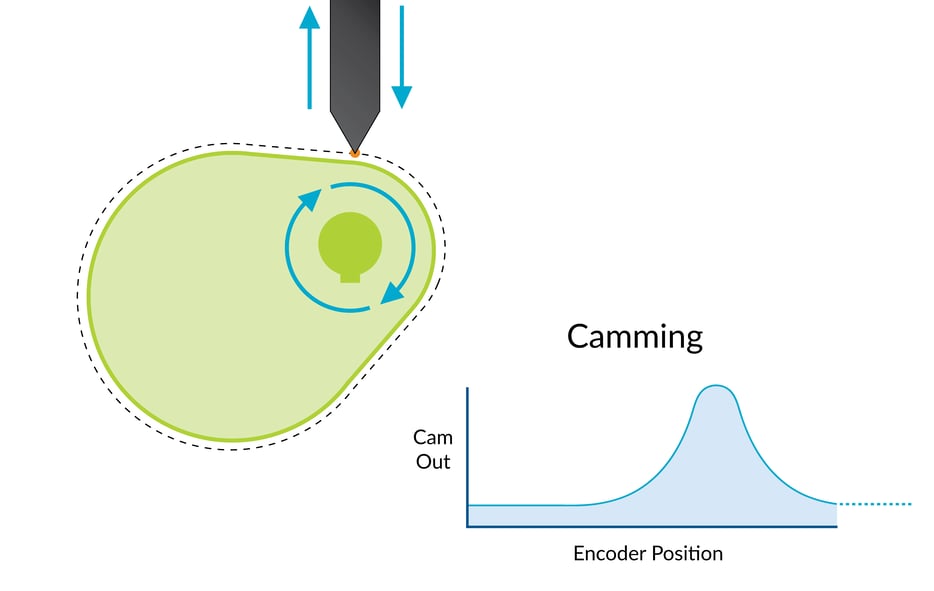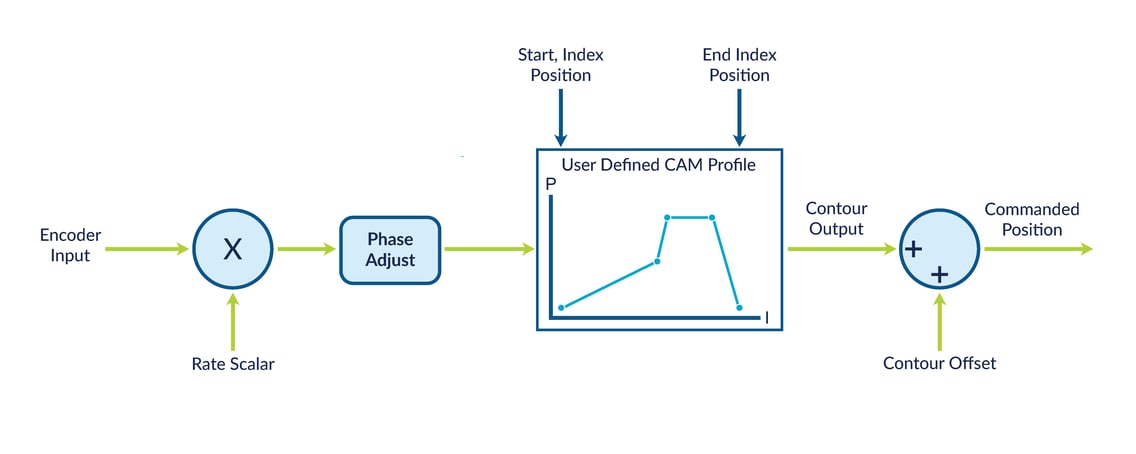CAM profiling is a general purpose motion technique utilizing a pre-stored look-up table of desired positions driven by an incoming command encoder datastream. CAMs are especially useful for encoding profiles which don’t follow a standard envelop such as a trapezoidal or parabolic profile. While originally used just to replicate mechanical rotating CAMs, electronic CAM profiling has grown to provide an array of profile generation and position compensation functions.
Basic CAM profiling uses an incoming encoder stream to create the lookup index for a table of pre-stored command positions. Many CAMs are encoded in a rotating frame with the last lookup value wrapping around to the first. The encoded values are usually interpreted as desired absolute command positions, but can also be interpreted as relative moves if so specified. The encoded table generally provides linear or spline interpolation between points to smooth the output commanded profile and to reduce the number of stored points needed.
For initialization during startup there is typically a physical signal which starts CAM lookup, after which position lookup and end-of-table wrapping continues automatically. Multiple CAM controllers driven by the same encoder data stream (often encoding the location of an incoming feed stock or conveyer belt) are common. This allows multiple processes to operate on the same feedstock simultaneously while staying fully synchronized with each other.

Most controllers, including those from Performance Motion Devices, provide additional CAM operating options. These include allowing the selection of alternate input datastream sources such as the output of another profile generator co-located in the same multi-axis controller. In this control mode the CAM table can be used as a general purpose coordinate system transformer, allowing relatively easy operation of SCARA arm type devices.
Alternate functions provided by electronic CAM controllers include use of the lookup table to store torque or position feedforward data. If an array of torque feedforward values is stored they can be used to compensate for known external forces stemming from the motor itself or the attached payload mechanism. If the encoded table data is interpreted as position feedforward values features such as lead screw mapping can be conveniently implemented.
The diagram below shows the control flow for PMD’s table-based (CAM Profile) system known as User Defined Profile Mode (UDPM). UDPM is a sophisticated system supporting basic as well as advanced CAM functions and is supported in special versions of PMD’s Magellan-based IC, module, and board products. Contact your PMD representative for details including how to order UDPM system developer kits.

Since 1994 Performance Motion Devices products have been used in a wide array of applications utilizing CAM profiling and related compensation techniques including 3-D printing, precision optics, glass manufacturing, key cutting, semiconductor robotics, microscopy focusing, and more. Our Magellan Motion Control ICs, ION Drives, and Prodigy Motion Control Boards all provide the vital motion control technologies you need to successfully build your next CAM profiling application.
PERFORMANCE MOTION DEVICES, INC.
80 Central Street | Boxborough, MA 01719
P: 978.266.1210 | F: 978.266.1211 | info@pmdcorp.com